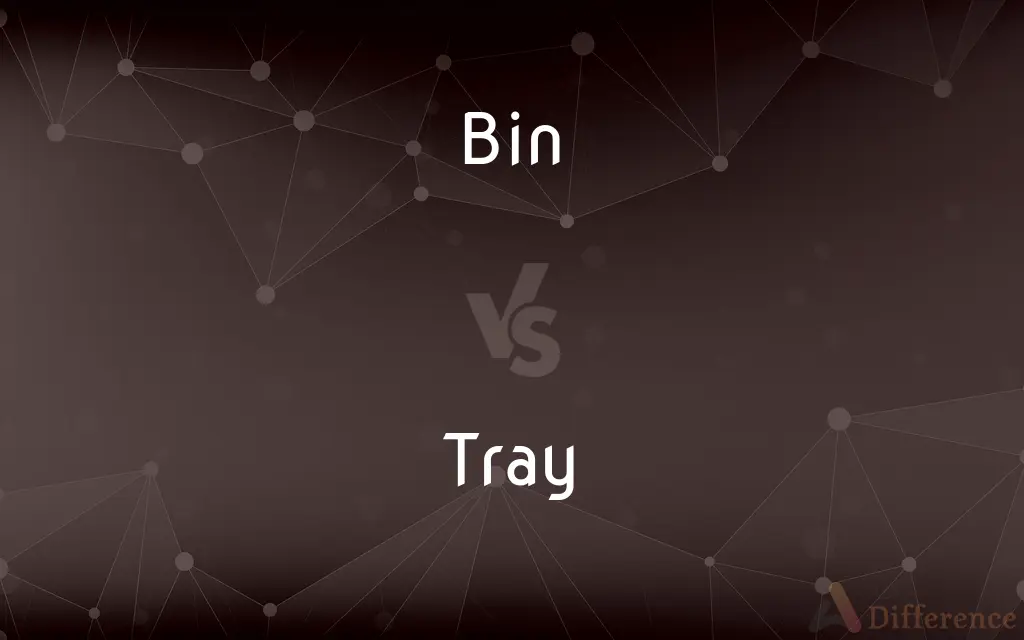Bin vs. Tray — What's the Difference?
Edited by Tayyaba Rehman — By Urooj Arif — Updated on April 15, 2024
A bin is a container used for storage or disposal of items, often with a lid, while a tray is a flat, open container used to carry or display items.

Difference Between Bin and Tray
Table of Contents
ADVERTISEMENT
Key Differences
Bins are typically larger, enclosed containers with varying capacities, designed for storing or disposing of a wide range of materials, from household waste to bulk items. Trays, on the other hand, are shallow and open, primarily used for carrying and organizing smaller items within easy reach.
While bins often come with lids or covers to conceal contents and contain smells, trays are usually lidless, facilitating easy access to the items displayed or carried on them.
The material used for bins is generally durable and resistant to wear or leakage, suitable for both indoor and outdoor conditions. Conversely, trays are often made from lighter materials like plastic, metal, or wood, designed for aesthetic appeal as well as functionality.
In terms of usage, bins are essential in waste management systems, organizational storage, and sometimes even in bulk material handling. Trays are more commonly used in settings like kitchens, dining areas, and offices to transport and organize items that need to be readily accessible.
The design of bins is influenced by practicality and efficiency, often with features like handles, wheels, or stackable structures to enhance functionality. Trays might also have handles, but their design focuses more on ease of use and surface area to maximize carrying capacity.
ADVERTISEMENT
Comparison Chart
Design
Enclosed, possibly with a lid
Open, flat
Material
Durable plastics, metal
Lighter materials like plastic, wood
Use
Storage, disposal
Carrying, displaying items
Size
Larger, varies widely
Smaller, designed for easy handling
Common Locations
Kitchens, outdoors, industrial areas
Kitchens, dining areas, offices
Compare with Definitions
Bin
Made from materials suitable for waste management.
The durable bin was designed to withstand heavy use.
Tray
A flat, open container used for carrying items.
She carried drinks to the guests on a tray.
Bin
A container used for storing or disposing of items.
She threw the packaging into the recycling bin.
Tray
Typically without a lid, designed for easy access.
The jeweler displayed rings on a plush tray.
Bin
Essential in waste management systems.
Every office had a bin under the desk for waste paper.
Tray
Often made of aesthetically pleasing materials.
The ornate silver tray was used for special occasions.
Bin
May include features for convenience like wheels.
He rolled the bin to the curb for garbage day.
Tray
May have handles to aid carrying.
The breakfast tray had handles on each side for stability.
Bin
Often larger and equipped with a lid.
The outdoor bin held all the garden tools.
Tray
Used in dining and organizational contexts.
The documents were organized neatly on a desk tray.
Bin
A container or enclosed space for storage.
Tray
A tray is a shallow platform designed for the carrying of items. It can be fashioned from numerous materials, including silver, brass, sheet iron, paperboard, wood, melamine, and molded pulp.
Bin
To place or store in a bin.
Tray
A flat, shallow container with a raised rim, typically used for carrying food and drink, or for holding small items or loose material
Seed trays
A baking tray
They ate supper off a tray in front of the fire
Bin
A box, frame, crib, or enclosed place, used as a storage container.
A corn bin
A wine bin
A coal bin
Tray
A shallow flat receptacle with a raised edge or rim, used for carrying, holding, or displaying articles.
Bin
A container for rubbish or waste.
A rubbish bin
A wastepaper bin
An ashes bin
Tray
A shallow flat receptacle with its contents
Took the patient a dinner tray.
Bin
(statistics) Any of the discrete intervals in a histogram, etc
Tray
A small, typically rectangular or round, flat, and rigid object upon which things are carried.
I carefully arranged the dishes on the tray and brought it upstairs.
Make sure that tray of eggs is properly loaded.
Bin
Any of the fixed-size chunks into which airspace is divided for the purposes of radar.
Tray
(by extension) The items on a full tray.
Before long they had consumed a whole tray of shrimp cocktails and sent for another.
Bin
Jail or prison.
Tray
A component of a device into which an item is placed for use in the device's operations.
The CD tray will not open.
The loader is responsible for placing the work on the trays for the plating machines.
Baking tray
Bin
(in Arabic names) son of; equivalent to Hebrew tr=ben.
Tray
A notification area used for icons and alerts.
Bin
(computing) binary
Tray
A type of retail or wholesale packaging for CPUs where the processors are sold in bulk and/or with minimal packaging.
Bin
To dispose of (something) by putting it into a bin, or as if putting it into a bin.
Tray
(Australia) The platform of a truck that supports the load to be hauled.
Bin
To throw away, reject, give up.
Tray
(obsolete) trouble; annoyance; anger
Bin
(statistics) To convert continuous data into discrete groups.
Tray
A gay trans person, particularly a man (a man who is both transgender and gay)
Bin
(transitive) To place into a bin for storage.
To bin wine
Tray
(transitive) to place (items) on a tray
Be sure to tray eggs with the large end up.
Bin
Alternative form of been
Tray
(intransitive) to slide down a snow-covered hill on a tray from a cafeteria.
Traying has provided collegiate fun and the occasional fatality for decades.
Bin
A box, frame, crib, or inclosed place, used as a receptacle for any commodity; as, a corn bin; a wine bin; a coal bin.
Tray
To grieve; to annoy
Bin
To put into a bin; as, to bin wine.
Tray
To betray
Bin
An old form of Be and Been.
Tray
To betray; to deceive.
Bin
A container; usually has a lid
Tray
A small trough or wooden vessel, sometimes scooped out of a block of wood, for various domestic uses, as in making bread, chopping meat, etc.
Bin
The quantity contained in a bin
Tray
A flat, broad vessel on which dishes, glasses, etc., are carried; a waiter; a salver.
Bin
An identification number consisting of a two-part code assigned to banks and savings associations; the first part shows the location and the second identifies the bank itself
Tray
A shallow box, generally without a top, often used within a chest, trunk, box, etc., as a removable receptacle for small or light articles.
Bin
Store in bins
Tray
An open receptacle for holding or displaying or serving articles or food
Common Curiosities
What types of materials are bins typically made from?
Bins are usually made from durable plastics or metals.
Can trays be used for storage?
Yes, trays can be used for storage, particularly for organizing and displaying items.
How do the uses of bins and trays differ in an office environment?
In an office, bins are used for disposing of waste, while trays might be used for organizing documents or office supplies.
Can trays be decorative as well as functional?
Absolutely, trays often serve decorative purposes, especially in settings like dining rooms or reception areas.
Are all bins equipped with lids?
Not all, but many bins, especially those for waste, have lids to contain contents and odors.
What considerations might influence the choice of a bin over a tray?
Storage needs, the necessity of covering contents, and outdoor use might make bins more suitable than trays.
What is the primary function of a tray in a kitchen setting?
In kitchens, trays are primarily used for carrying ingredients, utensils, or food from one area to another.
Are bins considered more durable than trays?
Typically, yes, as bins are designed to handle heavier loads and more rigorous conditions.
What sizes do bins typically come in?
Bins can range from small desktop varieties to large commercial or industrial sizes.
In what ways can trays be customized?
Trays can be customized in terms of material, color, size, and decorative elements to suit specific needs or aesthetics.
How do materials used in trays impact their use?
Lighter materials make trays easier to handle and carry, but may not be as durable as those used in bins.
Do trays come in different shapes?
Yes, trays can be round, rectangular, or various other shapes, depending on their intended use.
Is it common for trays to have features like wheels or stackability?
Wheels are uncommon, but some trays are designed to be stackable to save space.
What types of bins are there?
There are many types, including recycling bins, compost bins, and storage bins.
How can trays aid in organization?
Trays help in organizing items by grouping similar objects together in a confined and easily accessible space.
Share Your Discovery

Previous Comparison
Slime vs. Gel
Next Comparison
Caporegime vs. UnderbossAuthor Spotlight
Written by
Urooj ArifUrooj is a skilled content writer at Ask Difference, known for her exceptional ability to simplify complex topics into engaging and informative content. With a passion for research and a flair for clear, concise writing, she consistently delivers articles that resonate with our diverse audience.
Edited by
Tayyaba RehmanTayyaba Rehman is a distinguished writer, currently serving as a primary contributor to askdifference.com. As a researcher in semantics and etymology, Tayyaba's passion for the complexity of languages and their distinctions has found a perfect home on the platform. Tayyaba delves into the intricacies of language, distinguishing between commonly confused words and phrases, thereby providing clarity for readers worldwide.















































